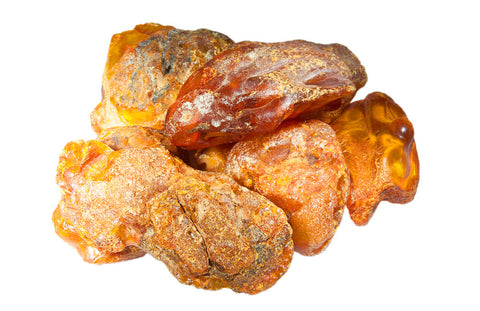Posted on 14 July 2017
You can cut, saw, and drill pieces of amber. The gemstone can also be sanded and filed, as well as carved.
Raw amber is relatively soft due to the fact that it’s made of fossilized resin and is not a mineral. However, Amber can easily be polished and manipulated due to this fact.
If you wish to saw it, it’s best to do so using a circular saw. The gem must be fed into the saw gently and firmly. If you would like to polish it by hand, you can use a fine-toothed saw. However, this method is more time-consuming as you will not be able to achieve a straight cut quickly.
The use of a sanding wheel or belt can help you shape amber into a desired size or form. Use a coarse grade wheel and belt to remove the material easily and a fine grade for final touches.
It’s possible to sand and file amber by hand. However, doing so can be a slower process than other methods that incorporate power tools. For example, a Dremel-type tool can be used to make intricate carvings relatively quickly. You can also utilize a dental-type Burr and saw.
After sanding the amber down to your desired size and shape, the surface will most likely still be fairly rough. You can do the final polishing using a cotton buffing wheel. When you’re working on the piece with a buffing wheel make sure to hold the piece tightly.
Opt for a good polish to load the buffing wheel and make sure to add it consistently as you finish polishing your amber piece. You can use a dental polish, however, avoid applying a neutral-colored polishing compound because it can cause discoloration to the gemstone’s surface.
Handling small pieces of amber is difficult. To remove stubborn bits of dirt, place a double-faced Scotch tape on your fingertip. Then, press it against your amber piece, changing your positioning each time. This method will help you clean your small piece of amber at a slow, controlled pace.

You can also drill the amber using the Dremel tool. To perforate a piece of amber completely, use a no. 62 twist drill. Drill it gently, but firmly. Ensure that you’re maintaining perfect alignment.
During the sanding and buffing process, the amber piece will warm up to a certain degree. However, you do not need to worry about this. If you have a solid piece of authentic amber, sanding or buffing the gem won’t cause it any harm. However, if you have soft grade amber, you should consider using water as a coolant when using the sanding wheel.
Things To Avoid
Since raw amber is fossilized resin, it is soluble in alcohol, chloroform, acetone and other chemicals. Therefore, try to avoid using polishes and finishings that contain the aforementioned chemicals.
Do not allow perfume or hairspray to come in direct contact with your amber, as some of the ingredients in these products can cause your piece to lose it shine forever.
When you cook or clean, do not wear an amber bracelet or ring, as many household materials contain harmful chemicals that can destroy amber.
Try not to expose it to direct sunlight for long periods of time.
Also, be sure to avoid exposing your amber to strong UV lights. After seven days of UV light exposure, your gemstone will begin to crack and crumble.
You should also avoid wearing or using your amber in extreme temperatures, as doing so risks causing damage to the resin.
Caring for Your Gemstone
Amber is a beautiful gem that looks stunning in any setting. To make sure that it stays beautiful it’s essential that you learn how to care for it properly.
To ensure that your gem continues to shine, make sure to apply a wax that’s silicon-based once every four to six months. This wax can also help prevent your piece from oxidizing.
Do not use a jewelry machine or steam cleaner when you polish or clean your amber, as these machines can damage your piece. Instead, use a warm water solution with a mild soap. Place the solution into a container and drop the amber into it. Leave it to sit for ten minutes, then remove the amber and dry it with a flannel cloth.
You can also place a drop of olive oil onto the amber and use a soft cloth to polish it.
Because amber is a not technically a stone, it is also not as stable as other gems you may own. Due to is being softer than most gemstones, amber should be stored separately from your other pieces of jewelry to avoid scratches.
To store your piece of amber wrap it in a soft cloth and place it in a separate jewelry box or pouch for safekeeping.
The Value of Amber
Amber is classified into translucent, transparent, semitransparent, and opaque. Low-transparent amber is called “bastard amber.” A fossilized resin that’s tainted with wood or any organic matter is graded based on its internal structure.
Jewelers usually prefer clear amber. However, translucent amber can look wooly, with some opaque sections. Assessing the value of amber requires a combination of the following factors: internal structure, outside appearance/quality, its age, and whether or not it contains entombed materials (e.g., bugs, bark, etc.).
Visible, but rare inclusions of entombed relics in amber can improve its price. Often, the resin is brought for assessment simply because of its inclusions, mainly because they are also proof of its authenticity.
The milky coloration seen in some amber pieces are a result of air bubbles and can be considered by some jewelers as defective. However, some jewelers make an exception. For example, a single large bubble can add value to the amber piece, since the bubble improves the play of color and light.
More Information About Amber
Amber has been around for thousands of years. People have used it to decorate palaces and to heal those struggling with physical ailments. Some even believe that the gemstone has magical qualities.
As we previously mentioned, amber is made-up of resin, which dropped to the ground and hardened through polymerization millions of years ago.
Amber that has not yet fully hardened is called “Copal.” You can differentiate Copal from Amber, due to the substance still being relatively soft.
Most of the world’s amber comes from the Baltic Sea. Baltic amber contains 98 percent succinite, which is said to provide health benefits.
Amber also comes in different colors other than the yellow. Opaque amber can have a creamy or foamy look. It looks beautiful if you place it in a silver setting, and is a variation of marble amber that comes with natural patterns.
Red amber, or “cherry amber,” is also known as dragon blood. It’s valued throughout history. The red tints are precious and very rare. You can also find black amber or dark brown amber.
Green amber is very rare, but it does exist. However, it’s so rare that some people doubt whether or not it’s a true gem when a piece is discovered.
Sources:





